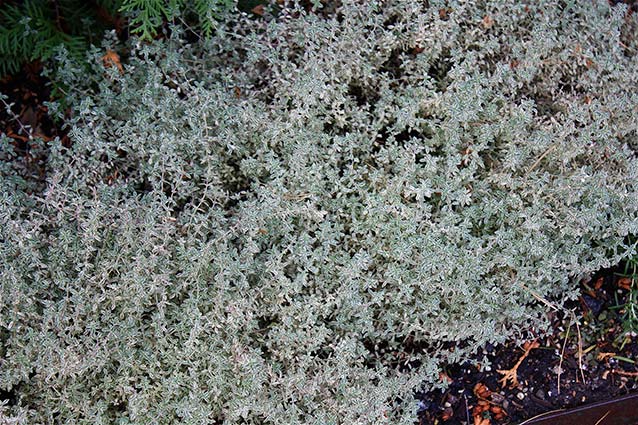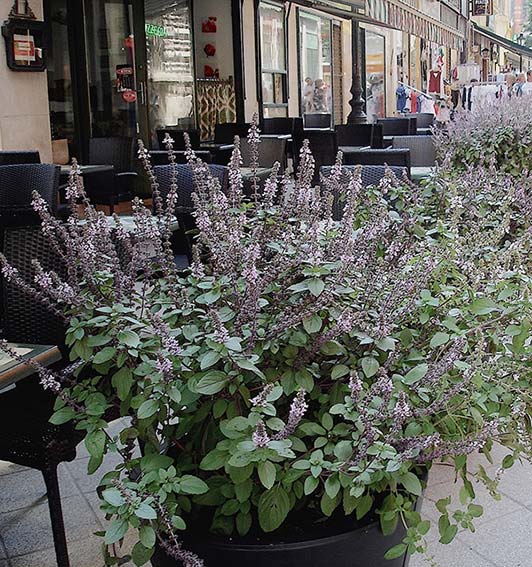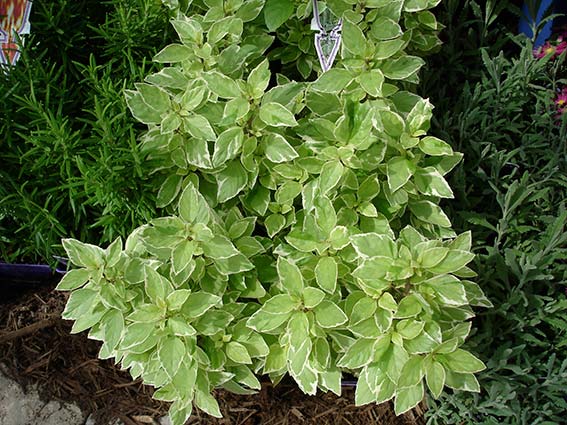How it Works: Preen Garden Weed Preventers
Here's how our Garden Weed Preventers prevent weeds before they even sprout rather than killing them after they’ve already had the chance to grow.
Almost anything goes this year in modern gardens. Why not celebrate the recent trend that highlights ornamental perennials, annuals, small shrubs, and even tropicals with veggies and culinary herbs. Certainly, herbs such as parsley, sage, rosemary, and thyme can also be used decoratively in the garden and in containers. Some, such as sage, have ornamental cousins such as variegated sage, Salvia officinalis 'Variegata', and purple sage, S. officinalis 'Purpurea' that provide as much flavor in a prettier package. Tall pineapple sage (S. elegans) leaves have a wonderfully fruity flavor, perfect to add to fresh fruit salads. 'Golden Delicious' has chartreuse foliage.
A small, sub-shrubby perennial, is often grown as an annual, as the stems become a little woody with age. The tiny leaves (most flavorful just before bloom-time) are strongly aromatic, and resist browsing from deer and rabbits. Whorls of diminutive pink flowers congregate at the stem tips and are favorites of butterflies and bees, which add another dimension to the garden. The selection 'Silver Posie' has silver-rimmed leaves. Lemon thyme (T. x citridorus), lime thyme (T. x. citriodorus ‘Lime’), caraway thyme (T. herba-barona), and T. 'Orange Balsam' enhance fish dishes, soups, and stews. Thymes are tough, attractive plants for rock and herb gardens, and as edgings. Use mother of thyme (T. serpyllum) and its selections 'Elfin', 'Pink Chintz', and 'Pygmaeus' as fragrant "walk-upon" ground covers.

© Ruth Rodgers Clausen
Easy-to-grow basil is grown as an annual. It should be planted outdoors only after the soil has warmed, and the danger of frost has passed. Start seeds indoors early or buy transplants. Remember that the latter has probably been greenhouse-grown and will need "hardening off" or acclimated gently to the outdoor temperatures. There seem to be dozens of varieties of culinary or sweet basil. Examples include lemony 'Mrs. Burn's Lemon'; dark purple-leaved 'Opal', which makes an attractive container; 'Lettuce-leaf' with its big corrugated leaves and ‘Large-leaf Italian’, both good for pesto; and 'Purple Ruffles', also good for pots. Anise-flavored 'Siam Queen' Thai basil is often used in Thai cooking but makes a striking 18"-24" clump, stunning in a large tub. Very small-leaved 'Spicy Globe' and 'Green Globe' are ideal as edging plants or in small vessels to decorate a table setting. The striking foliage of O. b. citriodorum 'Pesto Perpetuo' is eye-catching with herbs, veggies, or ornamentals.

© Ruth Rodgers Clausen
In edible landscapes, chives are often used as edging plants. Stocky and neat, with aromatic grass-like leaves, chives are indispensable in the kitchen and look splendid outlining beds and borders. Their edible flowers, much valued for making vinegar, are attractive in salads or as a garnish too. They grow from small onion-like structures and are winter hardy in most regions. The blue-green leaves of 'Grolau' are extra flavorful; ‘Profusion’ is excellent in containers. Garlic or Chinese chives (A. tuberosum) are similar but with flattened leaves. The heads of white starry flowers on 18" stems are especially attractive in monochromatic white borders or against a dark-leaved ground cover. Attracts pollinators.
Most chefs seem to prefer the flat-leaved or Italian parsley, and use the curly type only as a garnish to embellish a dish. In the garden, however, beautiful curly parsley is frequently used as an attractive edging plant. Since black swallowtail caterpillars a.k.a. parsley worm caterpillars, feast on parsley (as well as dill, rue, and other herbs), it is one of the staple plants in butterfly gardens. Parsley grows as a biennial, that the first season it produces only foliage, which is usually what we harvest; the second year it produces a thickened and flavorful root (parsley root) as well as a flower stalk (similar to Queen Anne’s lace). Start seeds indoors or directly in the garden. It is slow to get going and takes several weeks to germinate but produces a nice clump of foliage for summer harvesting. Space about 9” apart or closer for an edging to rose or perennial gardens; tomatoes and asparagus are appropriate companions in veggie gardens.

© Ruth Rodgers Clausen
Grown more widely as a reseeding, ornamental annual than as a culinary herb. However it has long been used as a substitute to produce the yellow color of saffron in cheeses and rice dishes, and today is a welcome, colorful addition to salads. The bright yellow or orange petals have a slightly sharp, spicy flavor. Countless generations of herbalists have used calendula to concoct skin healing potions for cuts and bruises, as well as for herbal tea. Start seeds outdoors in a sunny spot when the soil has warmed. Space the plants 10"-12" apart. They require little care.